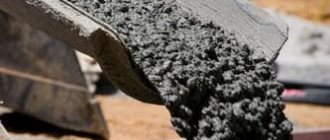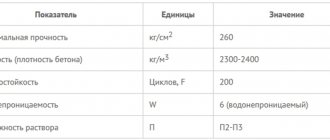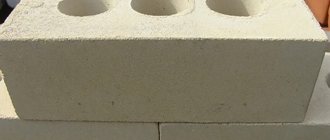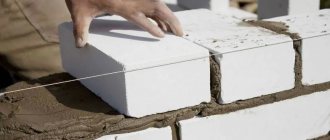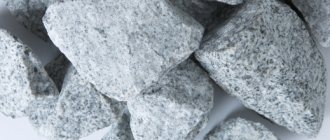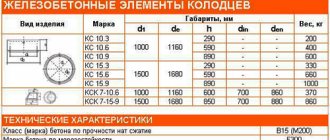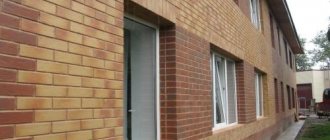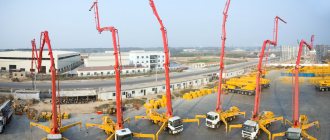Ready-made masonry cement mortar grade 100 is intended primarily for filling joints in walls, including load-bearing ones, made of heavy natural stone and large bricks. It can be purchased from most concrete manufacturers or made directly on the construction site from a special factory-made dry mixture, diluted with water. Grade M100 indicates the compressive strength of the hardened mortar on the 28th day after completion of work - not less than 100 kgf/cm² (10 MPa).
Cement for preparing masonry mortar.
Preface
1 DEVELOPED by the State Central Research and Design Institute for Complex Problems of Building Structures and Structures named after V.A. Kucherenko (TsNIISK named after V.A. Kucherenko), Research, Design and Technological Institute of Concrete and Reinforced Concrete ( NIIZHB), with the participation of JSC "Experienced Rosconitstroy" of the Russian Federation
INTRODUCED by the State Construction Committee of Russia
2 ADOPTED by the Interstate Scientific and Technical Commission for Standardization, Technical Regulation and Certification in Construction (MNTKS) on November 12, 1998.
Voted for acceptance
| State name | Name of the state construction management body |
| Republic of Armenia | Ministry of Urban Development of the Republic of Armenia |
| The Republic of Kazakhstan | Committee on Housing and Construction Policy under the Ministry of Energy, Industry and Trade of the Republic of Kazakhstan |
| Republic of Kyrgyzstan | State Inspectorate for Architecture and Construction under the Government of the Kyrgyz Republic |
| The Republic of Moldova | Ministry of Territorial Development, Construction and Communal Services of the Republic of Moldova |
| Russian Federation | Gosstroy of Russia |
| The Republic of Tajikistan | State Construction Committee of the Republic of Tajikistan |
| The Republic of Uzbekistan | State Committee for Architecture and Construction of the Republic of Uzbekistan |
3 INSTEAD GOST 28013-89
4 ENTERED INTO EFFECT on July 1, 1999 as a state standard of the Russian Federation by Decree of the State Construction Committee of Russia dated November 29, 1998 N 30
5 EDITION (July 2022), with Amendment No. 1 (IUS 11-2002)
Information about changes to this standard is published in the annual information index “National Standards”, and the text of changes and amendments is published in the monthly information index “National Standards”. In case of revision (replacement) or cancellation of this standard, the corresponding notice will be published in the monthly information index “National Standards”. Relevant information, notices and texts are also posted in the public information system - on the official website of the Federal Agency for Technical Regulation and Metrology on the Internet (www.gost.ru)
1 area of use
This standard applies to mortars with mineral binders used for masonry and installation of building structures during the construction of buildings and structures, fastening cladding products, and plaster.
The standard does not apply to special solutions (heat-resistant, chemical-resistant, fire-resistant, heat- and waterproofing, grouting, decorative, tensile, etc.).
The requirements set out in 4.3-4.13, 4.14.2-4.14.14, sections 5-7, appendices B and D of this standard are mandatory.
Flooring composition
The most significant difference between a conventional solution with the addition of polymers and the one that should be used for flooring is that it has higher abrasion resistance and also does not generate dust during wear. Most often, PVA dispersions or styrene-butadiene latexes are used to compose such a base. If you add latex in an amount of 15-20%, you can increase the abrasion resistance by 4-5 times; if you add the same amount of PVA dispersion, you can only achieve an increase in this parameter by 3 times.
If we draw a conclusion from all of the above, then we can say with confidence that the use of a regular mixture is no longer so relevant. The presence of various additives is quite justified, even if this slightly increases the cost of the mixture.
5 Acceptance rules
5.1 Mortar mixtures must be accepted by the manufacturer's technical control.
5.2 Mortar mixtures and solutions are accepted in batches through acceptance and periodic control.
A batch of mortar mixture and mortar is taken to be the quantity of a mixture of the same nominal composition with the same quality of its constituent materials, prepared using a single technology.
The volume of the batch is established by agreement with the consumer - no less than the output of one shift, but no more than the daily output of the mortar mixer.
5.3 All mortar mixtures and solutions are subject to acceptance control according to all standardized quality indicators.
5.4 When accepting each batch, at least five spot samples are taken from the mortar mixture.
5.4.1 Spot samples are taken at the place of preparation of the mortar mixture and/or at the place of its use from several batches or places in the container into which the mixture is loaded. Sampling points from the tank should be located at different depths. With a continuous supply of the solution mixture, point samples are taken at irregular intervals for 5-10 minutes.
5.4.2 After selection, spot samples are combined into a total sample, the mass of which must be sufficient to determine all controlled quality indicators of mortar mixtures and solutions. The selected sample is thoroughly mixed before testing (with the exception of mixtures containing air-entraining additives).
Mortar mixtures containing air-entraining, foaming and gas-forming additives are not additionally mixed before testing.
5.4.3 Testing of the mortar mixture, ready for use, should begin during the period when the normalized mobility is maintained.
5.5 The mobility and average density of the mortar mixture in each batch is monitored at least once per shift by the manufacturer after unloading the mixture from the mixer.
The humidity of dry mortar mixtures is controlled in each batch.
The strength of the solution is determined in each batch of the mixture.
Standardized technological indicators of the quality of mortar mixtures provided for in the supply contract (average density, temperature, delamination, water-holding capacity) and frost resistance of the solution are monitored within a time frame agreed with the consumer, but at least once every 6 months, as well as when the quality of the initial ones changes materials, composition of the solution and technology for its preparation.
5.6 Radiation-hygienic assessment of materials used for the preparation of mortar mixtures is carried out according to quality documents issued by enterprises that supply these materials.
In the absence of data on the content of natural radionuclides, the manufacturer determines the specific effective activity of natural radionuclides of materials in accordance with GOST 30108 once a year, as well as with each change of supplier.
5.7 Mortar mixtures, ready for use, are dispensed and taken by volume. The volume of the mortar mixture is determined by the output of the mortar mixer or by the volume of the transport or measuring container.
Dry mortar mixtures are released and taken by weight.
5.8 If, when checking the quality of the mortar, a discrepancy is revealed in at least one of the technical requirements of the standard, this batch of mortar is rejected.
5.9 The consumer has the right to carry out a control check of the quantity and quality of the mortar mixture in accordance with the requirements of this standard according to the methods of GOST 5802.
5.10 The manufacturer is obliged to inform the consumer, upon his request, the results of control tests no later than 3 days after their completion, and if the standardized indicator is not confirmed, notify the consumer immediately.
Adhesive properties
Such compositions exhibit increased adhesion, which is explained as follows. When applying the mixture, the polymer concentrates at the interface and acts as an adhesive base between the solution and the base. As for the adhesion itself, it directly depends on the type of added polymer, as well as its concentration. Next, it is worth saying that this property manifests itself only when the solution is dried under air-dry conditions. Therefore, for example, plaster with a polymer-cement mortar applied to the walls will be an excellent basis for installation. If hardening occurs in water, then adhesion will not work as well, even with a huge concentration of polymer. This is due to the fact that stabilizers dissolve in water, and some additives are even capable of changing their properties if they are in a liquid medium.
It can be added that a high level of adhesion affects not only improved adhesion to other materials, but also the mechanical characteristics of the solution itself. This is especially noticeable when tensile and bending loads occur. For mixtures with additives, these indicators are approximately 10 times higher than for conventional ones. This is due to the fact that the polymer layers bind the mineral components together. There is also such a characteristic as the elastic modulus, which is about 10 times lower than the usual one. Thanks to this fact, we can safely say that the polymer composition is more deformable than an ordinary one.
6 Control methods
6.1 Samples of mortar mixtures are taken in accordance with the requirements of 5.4, 5.4.1 and 5.4.2.
6.2 Materials for preparing mortar mixtures are tested in accordance with the requirements of standards and technical specifications for these materials.
6.3 The quality of chemical additives is determined by the effectiveness of their effect on the properties of mortars in accordance with GOST 30459.
6.4 The concentration of the working solution of additives is determined with a hydrometer according to GOST 18481 in accordance with the requirements of standards and technical specifications for specific types of additives.
6.5 The specific effective activity of natural radionuclides in materials for the preparation of mortar mixtures is determined according to GOST 30108.
6.6 Mobility, average density, water-holding capacity and stratification of mortar mixtures are determined according to GOST 5802.
6.7 The volume of entrained air in mortar mixtures is determined according to GOST 10181.
6.8 The temperature of freshly prepared mortar mixtures is measured with a thermometer, immersing it in the mixture to a depth of at least 5 cm.
6.9 Compressive strength, frost resistance and average density of hardened solutions are determined according to GOST 5802.
6.10 The moisture content of dry mortar mixtures is determined according to GOST 8735.
Technical characteristics of the M100 mixture
Properties of cement-sand masonry mixtures grade M100:
- viability in an open container - 1-2 hours;
- adhesion strength to the surface - up to 0.5 MPa;
- work temperature - +5...+25°С;
- operating temperature - -30…+40°С;
- volume of water per 1 kg of mixture - up to 0.23 l;
- masonry joint thickness - 10-15 mm;
- consumption per 1 m² with a thickness of 1 mm - up to 2 kg.
Characteristics of the hardened mortar
The main properties of M100 cement mortar on the 28th day after completion of masonry or installation work:
- average density - for light solutions up to 1500 kg/m², for heavy ones - from 1500;
- frost resistance - from F10 to F200 (from 10 to 200 freeze-thaw cycles without loss of properties);
Each manufacturer has its own exact values; the required ones are included in the construction project.
7 Transportation and storage
7.1 Transportation
7.1.1 Mortar mixtures, ready for use, should be delivered to the consumer in vehicles specifically designed for their transportation.
With the consent of the consumer, transportation of mixtures in bunkers (tubs) is allowed.
7.1.2 The methods used for transporting mortar mixtures must exclude the loss of binder dough, the ingress of atmospheric precipitation and foreign impurities into the mixture.
7.1.3 Packaged dry mortar mixtures are transported by road, rail and other modes of transport in accordance with the rules for the transportation and securing of goods in force for this type of transport.
7.2 Storage
7.2.1 Mortar mixtures delivered to the construction site, ready for use, must be reloaded into mixer loaders or other containers, provided that the specified properties of the mixtures are maintained.
7.2.2 Packaged dry mortar mixtures are stored in covered, dry rooms.
Bags of dry mixture must be stored at a temperature not lower than 5°C under conditions that ensure the safety of the packaging and protection from moisture.
7.2.3 The shelf life of the dry mortar mixture is 6 months from the date of preparation.
At the end of the storage period, the mixture must be checked for compliance with the requirements of this standard. If compliant, the mixture can be used for its intended purpose.
Additional items
It is worth noting that all the characteristics of a polymer cement solution can be lost if a process such as coagulation or curdling of the solution occurs during the addition of a polymer dispersion. Most often, to avoid such negative consequences, various stabilizers are used. They usually choose surfactants (surfactants) - OP-7 or OP-Yu. It is also possible to replace them with a small group of electrolytes, for example, liquid glass. Only a polymer-cement mortar, which was mixed based on a plasticized PVA dispersion, can do without the addition of a stabilizer.
However, the introduction of surfactants does not pass without a trace. Most often, these substances act as powerful foaming agents, and they are also capable of drawing air into the mortar mixture. If this happens, then the smallest air bubbles that were involved can reach 30% of the total mass of the solution.
APPENDIX A (for reference)
List of regulatory documents
GOST 4.233-86 SPKP. Construction. Construction solutions. Nomenclature of indicators
GOST 125-79 Gypsum binders. Specifications
GOST 2226-2013 Bags made of paper and combined materials. General technical conditions
GOST 2642.5-2016 Refractories and refractory raw materials. Methods for determining iron (III) oxide
GOST 2642.11-97 Refractories and refractory raw materials. Methods for determining potassium and sodium oxides
GOST 3594.4-77 Molding clays. Methods for determining sulfur content
GOST 5578-94 Crushed stone and sand from ferrous and non-ferrous metallurgy slags for concrete. Specifications
GOST 5802-86 Construction mortars. Test methods
GOST 8735-88 Sand for construction work. Test methods
GOST 8736-2014 Sand for construction work. Specifications
GOST 9179-77 Construction lime. Specifications
GOST 10178-85 Portland cement and Portland slag cement. Specifications
GOST 10181-2014 Concrete mixtures. Test methods
GOST 10354-82 Polyethylene film. Specifications
GOST 18481-81 Hydrometers and glass cylinders. Specifications
GOST 21216-2014 Clay raw materials. Test methods
GOST 21216-2014 Clay raw materials. Test methods
GOST 22266-2013 Sulfate-resistant cements. Specifications
GOST 23732-2011 Water for concrete and mortars. Specifications
GOST 24211-2008 Additives for concrete and mortars. General technical conditions
GOST 25328-82 Cement for mortars. Specifications
GOST 25592-91 Ash and slag mixtures from thermal power plants for concrete. Specifications
GOST 25818-2017 Fly ash from thermal power plants for concrete. Specifications
GOST 25820-2000 Lightweight concrete. Specifications
GOST 26633-2015 Heavy and fine-grained concrete. Specifications
GOST 26644-85 Crushed stone and sand from thermal power plant slag for concrete. Specifications
GOST 30108-94 Construction materials and products. Determination of specific effective activity of natural radionuclides
GOST 30459-2008 Additives for concrete. Methods for determining effectiveness
SNiP II-3-79* Construction heating engineering
APPENDIX B (recommended)
Mobility of the mortar mixture at the site of application depending on the purpose of the solution
Table B.1
| Main purpose of the solution | Cone immersion depth, cm | Mobility grade P |
| A Masonry: | ||
| — for rubble masonry: | ||
| vibrated | 1-3 | P1 |
| unvibrated | 4-6 | P2 |
| - for masonry made of hollow bricks or ceramic stones | 7-8 | P2 |
| - for masonry made of solid bricks; ceramic stones; concrete stones or light rock stones | 8-12 | P3 |
| - for filling voids in masonry and supplying with a mortar pump | 13-14 | P4 |
| — for making a bed when installing walls made of large concrete blocks and panels; jointing horizontal and vertical joints in walls made of panels and large concrete blocks | 5-7 | P2 |
| B Facing: | ||
| — for fastening slabs of natural stone and ceramic tiles to a finished brick wall | 6-8 | P2 |
| — for fastening cladding products of lightweight concrete panels and blocks in the factory | ||
| In Plastering: | ||
| soil solution | 7-8 | P2 |
| spray solution: | ||
| with manual application | 8-12 | P3 |
| with a mechanized application method | 9-14 | P4 |
| coating solution: | ||
| without the use of gypsum | 7-8 | P2 |
| using gypsum | 9-12 | PZ |
Special mortars
- To fill joints in prefabricated reinforced concrete structures, compositions based on cement and quartz sand are used without the use of additives that provoke the development of corrosion (SNiP 2.03.11-85), their mobility is 7–8 cm. The marking of the solution used must correspond to the marking of the concrete from which they are made connected elements.
- Injection solutions contain cement and sand and are used to fill channels of prestressed structures. Their strength corresponds to grades M300 and higher. The material is also distinguished by its water-retaining ability and frost resistance. To reduce the viscosity of this type of construction mixture, soap naft or SDB additives can be used.
- The composition of waterproofing solutions includes cement grades M400 and higher and quartz or artificial heavy sand. If structures made from such material will be exposed to an aggressive environment, sulfate-resistant Portland cement - ordinary or pozzolanic - is also added to them. To ensure waterproofness of seams and joints, the solution is mixed with waterproof expanding cement.
- Grouting solutions are necessary for plugging wells. All types of this category of compounds set quickly and have high water yield. By filling voids and cracks in the rock, they are able to withstand the pressure of groundwater and be resistant to aggressive environments. Depending on the conditions in which the solution will be used, it can be made on the basis of pozzolanic, sulfate-resistant Portland cement or slag Portland cement - for aggressive environments - or on the basis of backfill Portland cement - if the waters are pressure.
- Acoustic solutions have sound-absorbing properties and are used for plastering walls. Gypsum, Portland cement, lime or a mixture of them, as well as caustic magnesite are added as binders. The filler is light sand with a fraction of 3–5 mm from slag, pumice, expanded clay and other substances.
- X-ray protective solutions are also used for plastering work - in X-ray rooms. The binders in them are cement and Portland cement, and the fillers are crushed barite and other heavy rocks. The material also includes lithium, hydrogen and cadmium.
APPENDIX B (required)
Clay for mortars. Technical requirements
These technical requirements apply to clay intended for the preparation of mortars.
B.1 Technical requirements for clay
B.1.1 The content of clay particles less than 0.4 mm in size must be no less than 30 and no more than 80%.
B.1.2 The content of sand particles larger than 0.16 mm should be no more than 30%.
B.1.3 The content of chemical components by weight of dry clay should not be more than %:
- sulfates and sulfides in terms of - 1;
- sulfide sulfur in terms of - 0.3;
- mica - 3;
- soluble salts (causing efflorescence and efflorescence):
total iron oxides - 14;
the sum of potassium and sodium oxides is 7.
B.1.4 Clay should not contain organic impurities in quantities that impart a dark color.
B.2 Clay testing methods
B.2.1 The granulometric composition of clay is determined according to GOST 21216.2 and GOST 21216.12.
B.2.2 The content of sulfates and sulfides in terms of is determined according to GOST 3594.4.
B.2.3 The content of sulfide sulfur in terms of is determined according to GOST 3594.4.
B.2.4 The mica content is determined by the petrographic method according to GOST 8735.
B.2.5 The content of the amount of iron oxide is determined according to GOST 2642.11.
B.2.6 Content of the sum of potassium oxide and sodium according to GOST 2642.5.
B.2.7 The presence of organic impurities is determined according to GOST 8735.
Finishing solutions.
There are finishing solutions - ordinary and decorative.
· Finishing mortars are prepared using cement, cement-lime, lime, lime-gypsum binders.
Depending on the area of application, finishing solutions are divided into solutions for external and internal plasters. The compositions of finishing solutions are established taking into account their purpose and operating conditions. These solutions must have the required degree of mobility, have good adhesion to the base and change little in volume during hardening, so as not to cause the formation of cracks in the plaster.
